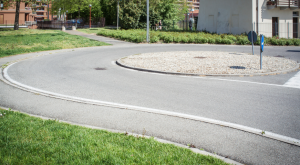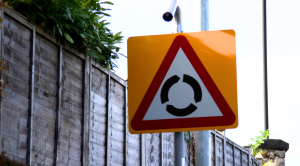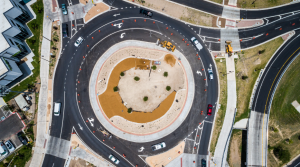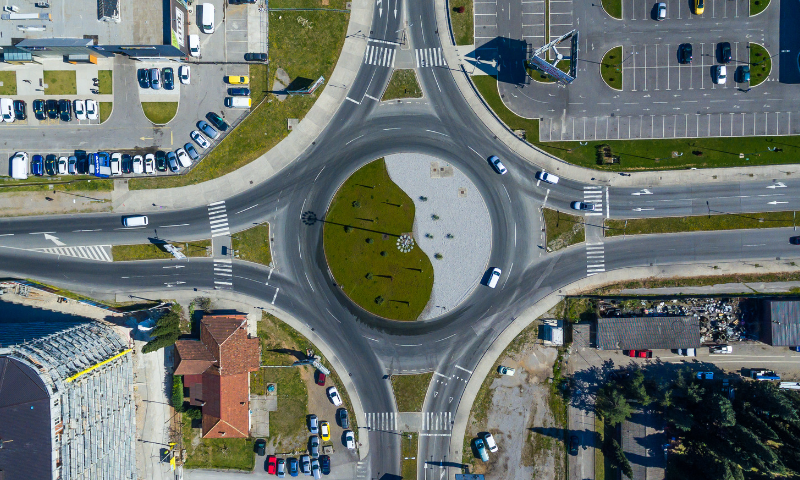Roundabouts can be intimidating for drivers who are not familiar with them. They are circular intersections that allow traffic to flow in a counterclockwise direction, and they have become increasingly popular in many regions across the world. Roundabouts offer numerous benefits over traditional intersections, including reduced traffic congestion and fewer accidents. However, if you’re new to driving in a roundabout, it can be tricky to navigate it successfully. In this blog, we’ll cover everything you need to know about driving in a roundabout, from what it is and why we have them to how they work and what lane you should be in. We’ll also share tips on successfully exiting a roundabout and driving safely through one. So buckle up, and let’s dive into the world of roundabouts!
What is a Roundabout?

A roundabout is a type of intersection where traffic flows around a central island in a counterclockwise direction. Roundabouts are designed to improve traffic flow and safety by reducing the number of conflict points and reducing the severity of crashes.
Why Do We Have Roundabouts?

Roundabouts are a type of intersection that is designed to improve traffic flow and safety. They are often used in place of stop signs or traffic signals at intersections. Roundabouts can help to reduce traffic congestion and delays, and they can also help to reduce the number of accidents at intersections.
There are several reasons why roundabouts may be used in place of other types of intersections. One reason is that roundabouts can help to reduce the number of conflicts between vehicles. When vehicles approach a roundabout, they must yield to traffic that is already in the roundabout. This reduces the potential for head-on collisions or right-angle collisions.
Another reason why roundabouts may be used is that they can help to improve traffic flow. Traffic signals and stop signs can cause delays when vehicles must wait for a green light or cross traffic to clear. Roundabouts allow traffic to keep moving, which can help to reduce congestion.
Roundabouts can also help to improve safety at intersections. Studies have shown that roundabout intersections have fewer accidents than stop signs or traffic signals. This is because drivers are less likely to run red lights or fail to yield at a roundabout.
How to Drive in a Roundabout?
How Do Roundabouts Work?

To use a roundabout, you need to follow these steps:
Check the signs and road markings before you approach the roundabout, and choose the correct lane for your exit. Generally, you should use the left lane for turning left or going straight ahead and the right lane for turning right or making a U-turn.
Check your mirrors and signal your intention. If you are turning left or right, signal left or right, respectively. Do not signal on approach if you are going straight ahead or making a U-turn.
Slow down and yield to the traffic already in the roundabout, which comes from your right. Wait for a safe gap before you enter the roundabout.
Once you are in the roundabout, follow the curve and stay in your lane. Do not change lanes or overtake other vehicles in the roundabout. Watch out for pedestrians, cyclists, and other road users.
Signal your exit as you pass the exit before yours. For example, if you are taking the third exit, signal right as you pass the second exit. If you are taking the first exit, signal left as soon as you enter the roundabout.
Exit the roundabout carefully and smoothly, and cancel your signal.
How to Exit a Roundabout Successfully?

Exiting a roundabout successfully requires careful navigation and adherence to traffic rules. As you approach your desired exit, make sure to signal your intention to exit by activating your turn signal. This will alert other drivers of your intentions and allow them to adjust their driving accordingly. Keep an eye on the road markings and signs as you approach the exit, ensuring that you are in the correct lane for your intended direction.
When it is safe, smoothly merge into the exit lane and gradually reduce your speed as you approach the exit ramp. Remember to yield to any pedestrians or vehicles already on the ramp, and always follow the guidance provided by traffic signs and signals. By following these steps, you can navigate roundabouts with confidence and exit safely.
Benefits of Roundabouts
Roundabouts offer numerous benefits compared to traditional intersections. First and foremost, they improve traffic flow and reduce congestion. The circular design allows vehicles to keep moving, eliminating the need for stoplights or stop signs. This results in smoother and more efficient traffic movement, especially during peak hours.
Additionally, roundabouts enhance safety by reducing the risk of severe accidents. Lower speeds and fewer conflict points significantly decrease the likelihood of high-speed crashes or T-bone collisions. Roundabouts also have environmental advantages as they promote fuel efficiency and reduce emissions due to the continuous flow of traffic. Overall, roundabouts are a win-win solution for improving community traffic flow, safety, and sustainability.
What is the Correct Way to Take a Roundabout?

As you approach a roundabout, check for traffic signs and markings that indicate which lane you should be in. If there are no signs or markings, yield to traffic already in the circle and enter to the right of the centre island.
Once you’re inside the roundabout, watch for vehicles entering the circle and yield to them as needed. Continue until you reach your exit point. If you miss your exit, don’t worry – go around the circle again until you reach it.
When exiting the roundabout, use your turn signal to let other drivers know which way you’re going. Then, merge into traffic and continue on your way.
How Do You Know What Lane to Be in at a Roundabout?
There are a few things to keep in mind when deciding which lane to be in at a roundabout. If you’re approaching the roundabout and there are no signs indicating which lane you should be in, the general rule is to stay in the right lane if you’re turning right or going straight and to stay in the left lane if you’re turning left.
If there are signs indicating which lane you should be in, make sure to follow those instructions. In some cases, the left lane may be for traffic exiting the roundabout, while the right lane is for traffic continuing around the roundabout.
If you’re not sure which lane you should be in, it’s always best to err on the side of caution and stay in the right lane until you’ve had a chance to assess the situation.
Tips on Driving in a Roundabout Safely

If you’re new to driving or are visiting a country where roundabouts are common, they can be a little daunting. But don’t worry, once you know the basics; they’re very easy – and much safer than intersections with traffic lights. Here are some tips on how to drive safely in a roundabout:
– Enter the roundabout when there is a gap in traffic.
– Give way to traffic already in the roundabout. If there is more than one lane, choose the lane that will take you to your exit.
– Use your indicator to signal your intention to leave the roundabout.
– Exit the roundabout when you reach your exit.
So long as you remember these basic rules, driving in a roundabout is actually quite simple – and much safer than an intersection with traffic lights!
Conclusion
In conclusion, driving in a roundabout may seem intimidating at first, but with proper understanding and practice, it can become second nature. Remember to yield to traffic already in the roundabout, choose the correct lane based on your desired exit, and signal before exiting. Take it slow and be aware of other drivers’ movements. Roundabouts improve traffic flow and enhance safety by reducing the risk of severe accidents. By following these tips and practising defensive driving, you can navigate roundabouts confidently and safely. Stay alert, be patient, and enjoy the smooth flow of traffic in the roundabout.









